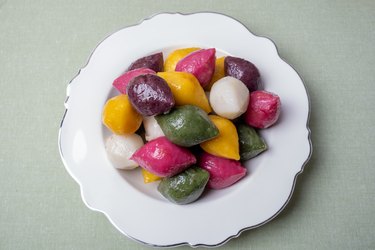When I was a kid, I never could've imagined anyone outside of South Korea celebrating Chuseok, a three-day holiday celebrating the harvest moon. While possibly the biggest holiday as well as one of the most important holidays in South Korea, my own parents didn't participate in most of the traditions of the harvest moon festival. And my grandparents on both sides were devout Christians who saw the Chuseok holiday feasts laid out on Jesa tables to honor ancestors akin to idol worship. So, instead, my father and uncles chose to celebrate (and avoid traffic!) by visiting and tidying my grandfather's grave site days later.
That was completely fine by me. Growing up in Seoul as a teen after spending most of my childhood in Chicago and Honolulu, I was happy that we didn't celebrate the harvest festival. One less family gathering meant one fewer grueling day helping my mother and aunts in the kitchen to make zucchini Jun, Gulbi (grilled salted fish), Galbi (short ribs) and other Banchan (side dishes). After all, holidays were a lot of work in my house, at least for the women. While I washed dishes and plated and served food, my brother did nothing but play and eat. The last thing I wanted was another Korean holiday to add to the lineup!
Video of the Day
Video of the Day

These days, though, things are different. Now that I'm a mother with two daughters who are curious about their Korean culture, I realized I've missed out on some meaningful traditions by not celebrating Chuseok. Luckily, as my daughters' palates have developed to appreciate a wider variety of foods, they're the ones who have prompted me to rediscover lesser-known delicacies and traditional holiday dishes from South Korea.
But who has time to hunt down obscure ingredients or cook labor-intensive meals? And, let's face it, we don't all have access to new Chuseok meal kits and delivery services that many in South Korea have at their disposal.
With that in mind, I'd like to suggest three very simple and authentic ways to celebrate Chuseok. But first...
A Quick Primer on Chuseok
Some dub Chuseok the "Korean Thanksgiving" or "Korean Thanksgiving Day." Like the American version, on Chuseok, people in South Korea travel home to have a feast with family, creating traffic jams and—yes—crowded airports. The focus for the Korean holiday, however, is to honor your ancestors by preparing a special Jesa table, called Charye. Some will do this at the gravesites of relatives just after tidying up the area, pulling weeds and watering the surroundings. Others will travel to the eldest offspring's home (traditionally the son's) or to their hometown.
Over time, Chuseok, like Christmas, has become a commercial, gift-giving holiday in South Korea, with big sales and lots of advertising. Unlike Christmas, though, Chuseok gifts are not toys for children but special gift sets for customers, clients and even bosses. Traditionally, these Chuseok gifts would include necessities but now include everything from Spam to skin care.
Most importantly, though, Chuseok differs from Thanksgiving in that it's more about hope than it is about gratitude. The timing of the holiday, the 15th day of the eighth month of the lunar calendar, often falls before or during and not after the autumn harvest. So, it seems more accurate to say that we're thanking ancestors in advance to respectfully make a request for bounty—hence the gifts to key decision-makers. Plus, another part of the holiday is to make wishes on the full moon.
Now, let's move on to easy ways to celebrate the holiday with authenticity, ease and joy.
3 Easy Ways to Celebrate Chuseok
1. Remember ancestors in the company of loved ones

Chuseok is a hopeful holiday. It's not about mourning but about honoring and celebrating those who have gone before us. Given how many have lost loved ones from COVID-19 and now with eased restrictions, it seems like the perfect time to gather with loved ones who remain.
My favorite way to do this? During dinner, go around the table and have each family member or friend respond to the following conversation starters and prompts:
1. Recall: One quirk or unique detail about them
2. Remember: A funny or memorable story that involves them
3. Share: A lesson you learned, big or small, from them
4. Notice: Something you inherited from them—not just physical traits but also values
These are especially helpful for family members who are younger and may not remember deceased grandparents or relatives. This activity not only models respect but nurtures stronger connections.
2. Try Korean rice cakes or partake in family favorites

Those who practice Jesa will prepare an elaborate meal and set a Charye table for the ancestor. There are rules about what to prepare (alcohol, soup, beef, fish, vegetables, fruits, rice and rice cakes). There are also directives on where to place the table as well as food placement. Once everything is set, there is a series of rituals performed in strict order that includes offerings of wine and food, bowing and finally the family dividing the food and eating together.
But to make things easy, simply try the holiday's most representative food: Songpyeon, a special kind of Korean rice cake. These are small, flat and round rice cakes that resemble the moon. They are folded into half-moon shapes and come with fillings that are usually sweet, such as sesame seeds with honey, or red bean, mung bean or chestnut pastes. You can find them at a local Korean grocery story or bakery.
But even if you can't make or find these or other delicious Korean fare, you can simply partake in whatever drink or food your beloved ancestor enjoyed most. After all, while Jesa tables can be quite elaborate, they were really meant to showcase ancestors' favorites from what was readily available.
3. Admire the moon...together

Let's not forget one of the most important components of Chuseok—the moon! Taking a walk and gazing up at the moon reminds us that we're a small part of a grander universe. This can help to shrink everyday worries to a manageable size. Going outdoors, being closer to nature and admiring the sky can also ground you, and doing this with loved ones can deepen your relationships as you honor the ancestors who connect you.
The harvest moon is typically larger and shines brighter than other full moons. Dalmaji, or to admire and "meet the moon," is perhaps the easiest Chuseok activity since all you need to do is look up.
Happy Chuseok!